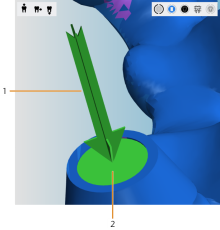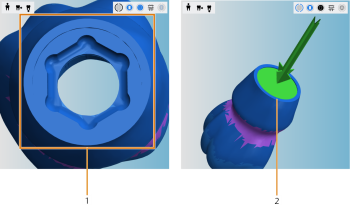Checking drilling ranges and cavities for proper marking
This procedure belongs to step 3 of the simple nesting workflow.
This procedure belongs to step 6 of the complete nesting workflow.
If you activated the automatic detection of cavities or drill holes in the STL import view, you need to check for all objects if DentalCAM has correctly recognized drill holes and cavities.
If the automatic detection has failed, mark the cavity or the drilling range manually.
The manual marking of drilling ranges and cavities is also required for objects for which you deactivated the corresponding detection function.
- Open the Nesting view for adjusting objects with the following icon in the main toolbar:

Checking drilling ranges
Drilling ranges can either be completely undetected or incorrectly marked. You need to thoroughly check both ends of every drill hole in your blank for both cases.
You may want to hide elements in the blank display for a better view. Showing/hiding elements of the blank display
How to check drilling ranges
- Switch to the bottom view. Toggling the view of the blank display
-
Zoom in on an object with at least 1 drill hole.
Adjust the viewpoint so that you can look onto the first end of the drill hole.
- Check whether the following applies:
- The opening surface of the drill hole is marked in green.
- The opening surface is even and doesn’t have any sharp bends
- In the case of a drill hole in a connection geometry, the entire connection geometry is covered by a green body.
- An arrow indicates the correct drilling direction (pointing perpendicularly “into” the drill hole).
- Arrow pointing perpendicularly into the drill hole
- Even opening surface marked in green
- Hexagonal connection geometry of an abutment without marking
- Correctly marked drilling range of the hexagonal connection geometry
- Repeat step 3 for the second end of the drill hole.
- If a drill hole hasn’t been recognized correctly, correct it manually via the editing function for specifying the drilling range

A correctly recognized drilling range

A correct drilling range for a hexagonal connection geometry
Examples of incorrectly marked drilling ranges
Checking cavities
Cavities can either be completely undetected or incorrectly marked. You need to thoroughly check every cavity in your blank for both cases.
How to check cavities
-
Switch to the bottom view. Toggling the view of the blank display
-
Zoom in on an object with a cavity.
-
Make sure that all cavities including the preparation line areas are marked green.
Other areas must not be marked green.
-
If a cavity hasn’t been recognized correctly, mark it manually via the editing function for marking cavities
Examples of incorrectly marked cavities
In the following example, DentalCAM fused 3 cavities into 1 incorrect cavity. You can see this in the enlarged view from below: The interdental space is wrongly marked green (indicated by the arrows):
What's next?
If drilling ranges or cavities need correcting:
Marking and deleting drilling ranges
All editing functions for objects:
Editing functions in the nesting view
If you are finished with adjusting objects:
If you are unsure whether you are finished nesting the current blank, see the simple and complete nesting workflow:









